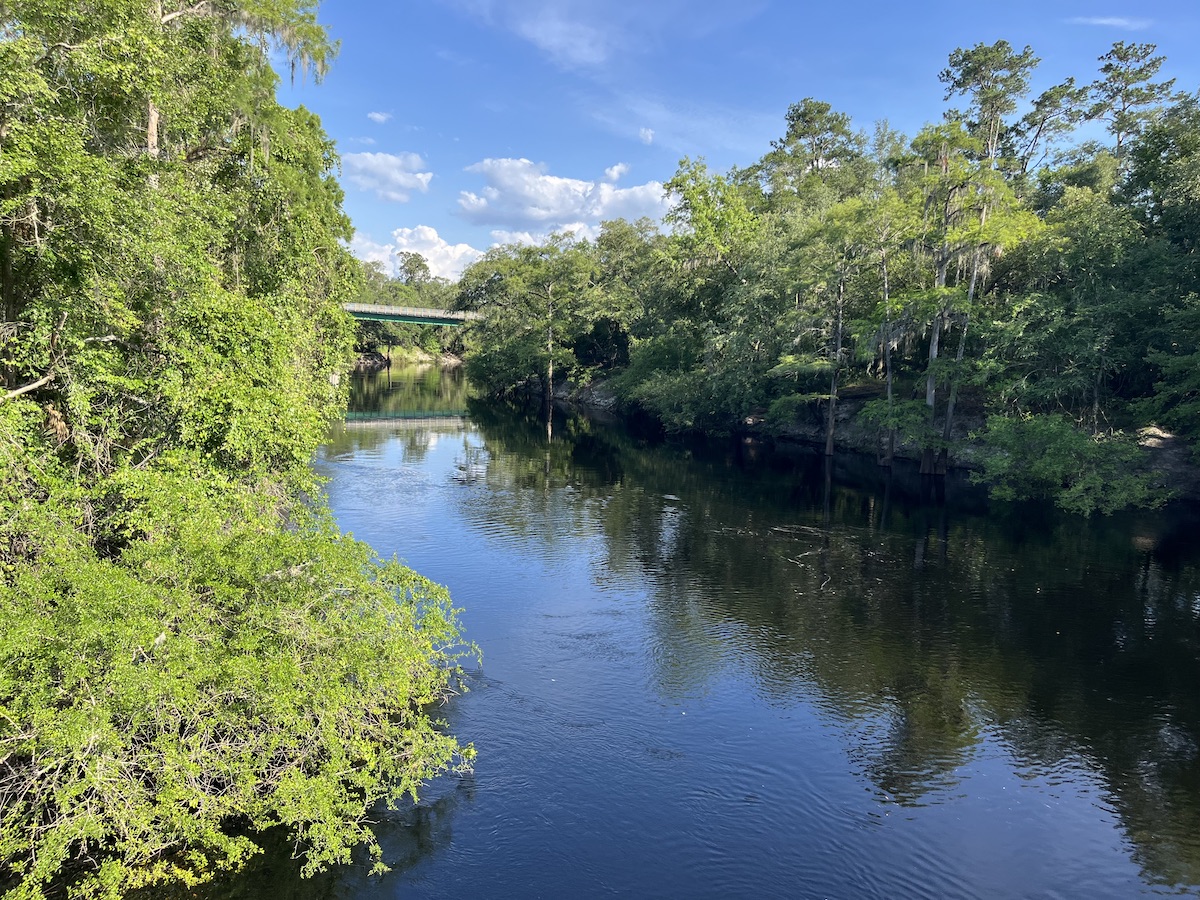
Seminole Spaces: Rich Heritage And Beautiful Tradition In White Springs
Welcome back to our Seminoles Spaces series! This week, we’re heading to White Springs, FL, just in time for the Florida Folk Festival! This year’s festival will be held May 24-26 at Stephen Foster Folk Culture Center State Park. Seminoles have been involved in the festival since it first began in 1953. Soon, they became an integral part of the festival events. Today, we will explore not only the Seminole presence in White Springs, but also the historic influence of Seminoles at the Florida Folk Festival over the last 72 years.
In our featured image, you can see a snapshot of the Suwanee River, taken from the walkway of the defunct Spring House, taken May 23, 2024 by the author.
White Springs
White Springs’ original claim to fame came from the sulfur hot springs located along the Suwanee River. The Spring House, on the edge of Stephen Foster Folk Culture Center State Park on US 41, sits on one of these sulfur springs. During the 1800s, white settlers developed the area as a ferry landing. Soon after, the mineral waters would be marketed to out-of-state tourists as a health curative. In 1836 Bryant Sheffield would purchase the ferry and the spring. He used local timber to construct a hotel and spring house.
By 1882, the area would be incorporated as White Springs, FL. At the turn of the 20th century, the complex would be entirely rebuilt. The spring house walls were made of cement and coquina, and side buildings were erected to house changing rooms and medical offices. The bath house featured four balcony levels (below) and tourists flocked to the healing springs.
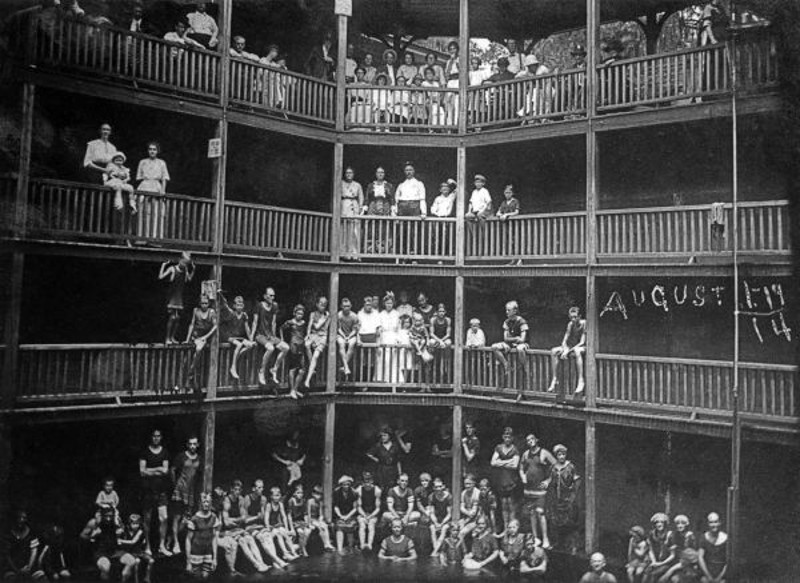
State Archives of Florida
White Sulphur Springs would attract tourists from the mid 1800s through the 1930s. Famous visitors included Theodore Roosevelt and Henry Ford. But, the sulfur springs had long been visited by Indigenous people and their curative properties were well known. Pre-colonization, Suwanee River was the loose boundary between the Timucuan to the east and Apalachee tribe to the west.
The “famed healing powers of the sulfur spring brought native warriors from both sides of the river.” It was considered a special, spiritual place of healing. The Timucuan would not survive European contact, with slavery, disease, and war fracturing their population. By the 1800s they had either fled to Cuba or integrated themselves within other tribes. Later, Seminoles would also visit the springs just as previous Seminole ancestors had.
The Spring House Today
Just a few hundred feet from the entrance to Stephen Foster Folk Culture Center State Park, the remnants of the original spring house still stand. Hiking down to the water from the road, you step out from lush foliage into the remarkable well-preserved structure. Below, you can see an image from the walkway of the spring house, looking down into the restorative waters. Water still flows from the Suwanee River through to the basin.
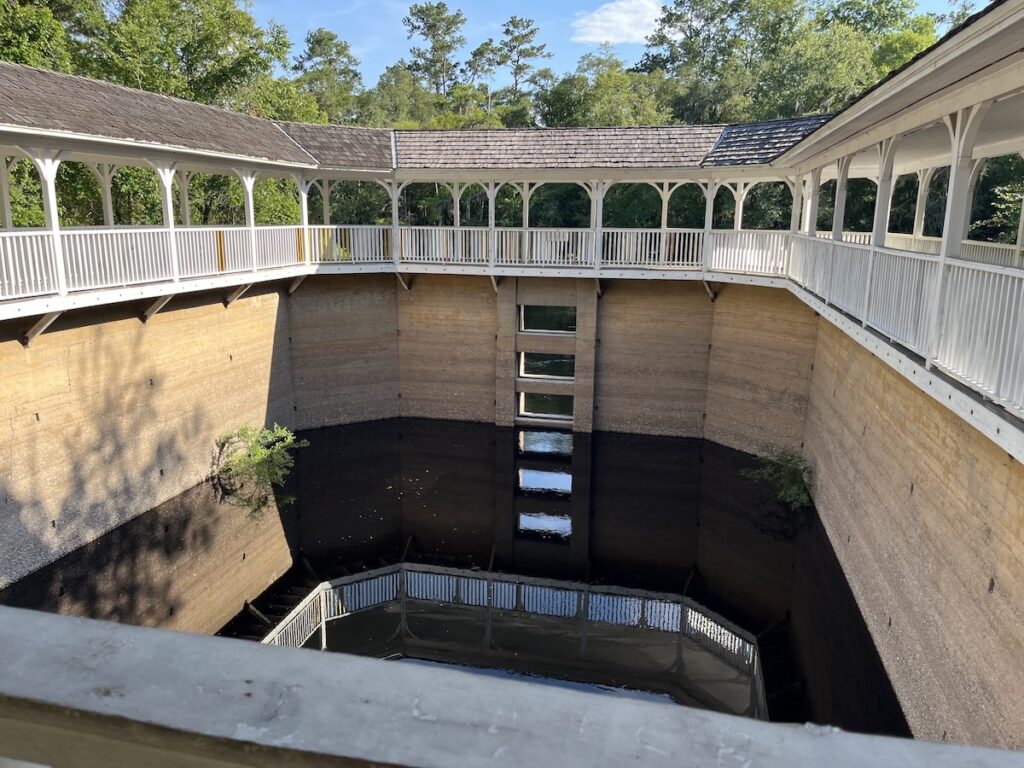
Encircling the natural spring, when operational the spring house had mechanical gates to keep the river out of the basin. The remnants can be seen in the image above. While wandering the circular walkway, you can also clearly see the coquina folded into the cement (below). So, what do you think, would you take a dip?

Seminoles at White Springs
Seminoles and Seminole ancestors have a long history in the White Springs area, and not only to visit the sulfur springs mentioned above. They have been a part of the Florida Folk Festival since its beginning, appearing in the first program for the first festival in 1953. Soon, their contributions to the festival would grow and flourish, changing to include demonstrations, singing, dancing, crafts, and food vendors.
Demonstrations of how to make patchwork clothing, carve Seminole dugout canoes, make sweetgrass baskets and dolls, and other Seminole traditions became integral parts of the festival offerings. Additionally, Seminole singing and dancing can be seen in audio and video recordings from the 1950s. During the early 20th century, visitors could take paddle boat and ferry rides along the Suwanee River. Below, you can see Lottie Shore and Mary Jane Willie (Shore) on an excursion boat trip on the Suwanee River during the 1958 Florida Folk Festival.
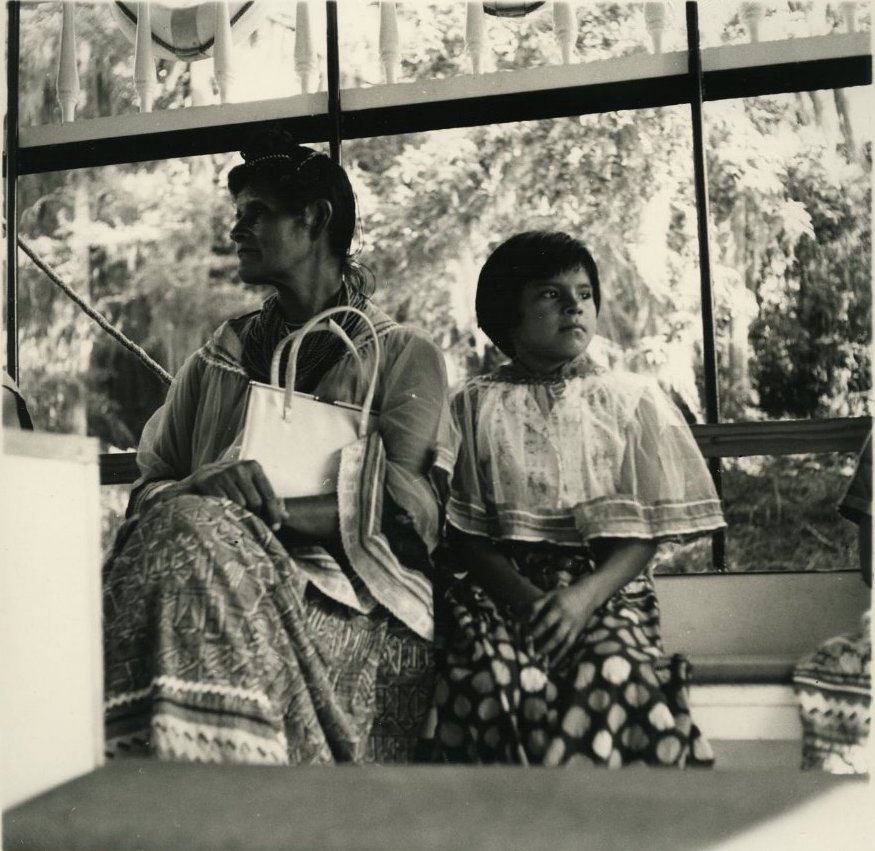
2009.34.1020, ATTK Museum
Today, we can still find many historic images and recordings of revered Seminole elders attending the Florida Folk Festival in its early days. Notably, Billy Bowlegs III, Naha Tiger, the Frank Shore family, and medicine man Josie Billie were regular attendees of the festival. They would wear traditional regalia, and share Seminole culture, story, and traditions. Bowlegs was known for dancing and singing traditional songs. Frank Shore would often share traditional knowledge about medicinal herbs and plants. Later, former Chairman James E. Billie and Paul Buster (and more!) would perform on the festival stage. In fact, in 2016 a 90-minute documentary Wrestling Alligators debuted at the Florida Folk Festival about the life and experiences of former Chairman James Billie. Below, you can see a photographic print of Naha Tiger and Billy Bowlegs at the Florida Folk Festival, May 2-4, 1958.
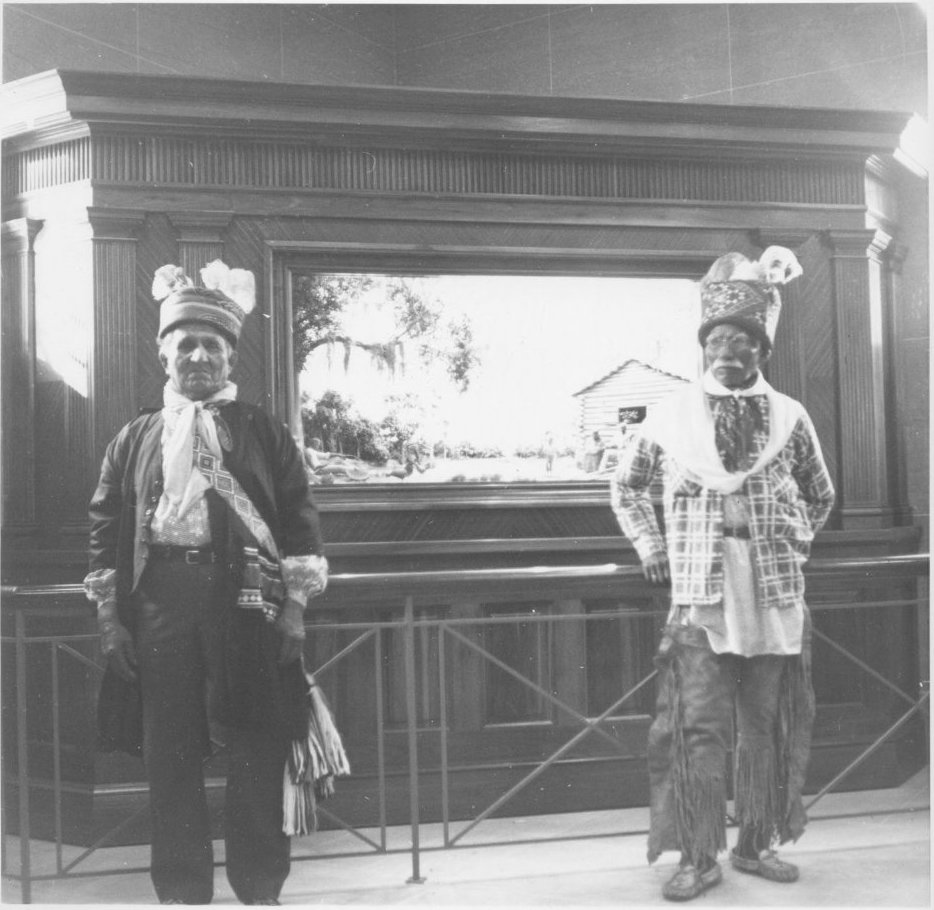
2009.34.1279, ATTK Museum
Stephen Foster Folk Culture Center State Park
The Florida Folk Festival is held annually at Stephen Foster Folk Culture Center State Park. It is located on the banks of the Suwanee River, west of Jacksonville. Originally opened in 1950 as the Stephen Foster Memorial, the first Florida Folk Festival was held there in 1953. The center honors the famed American composer, Stephen Foster. Foster wrote “Old Folks at Home,” which made the Suwanee River famous. Below, you can see Billy Bowlegs III, Frank Shore, Lottie Shore, and their children at the 1958 Florida Folk Festival. The original name of the memorial is emblazoned on a sign between them.

State Archives of Florida
Today, the original memorial area is protected as a Florida State Park. Visitors can enjoy numerous opportunities to hike, bike, canoe, fish, camp, and view local wildlife. The park also features a 97-bell carillon which plays Stephen Foster’s music throughout the daytime. The picturesque park is located right on the banks of the Suwanee River, and the 800-acre park features a diverse variety of landscapes including swamp forest, river bluffs, and limestone outcroppings. Beyond the park, White Springs also boasts a 4-mile section of the Florida Trail, which spans from one edge of the historic town to the other.
Florida Folklife Festival 2024
This year’s festival is being held May 24-26th, 2024, and the three day festival is an exploration and celebration of Florida heritage. It is the longest running state folk festival in the United States, and this year marks the 72nd annual event. Like the decades of the past, Seminoles are still an integral part of the festival line up! We hope you stop by the festival and enjoy the rich and diverse culture and heritage that can be found in our Sunshine State.
Seminole Family Camp
The Florida Folk Festival includes a Seminole Family Camp which includes the Cheekee-chobee (big chickee) Performance Stage. The Seminole Family Camp, which is now located near the Craft Square, was donated by the Seminole Tribe of Florida. Under the chickee, you’ll find Seminole artisans sharing their traditional knowledge of Seminole arts, crafts, and more!
Demonstrations
There are a variety of Seminole artisans this year at the festival sharing their artistry and skill with visitors. Nancy Shore will demonstrate patchwork sewing. Shore has been attending the Florida Folk Festival since she was a young child with her parents, Frank and Lottie Shore. Now, she carries on the patchwork and beading traditions passed down from her mother, which she will demonstrate at this year’s festival. Onnie Osceola will demonstrate contemporary Seminole beadwork, which includes necklaces, sashes, and belts. Carla Cypress will demonstrate Seminole doll-making. Seminole dolls are incredibly unique, and the striking crafting tradition uses palmetto fiber for the bodies and dresses them in hand-sewn traditional clothing.

WHITE SPRINGS, FLA. 5/27/17-Seamstress Nancy Shore works with fabric in the Seminole Family Camp, Saturday during the Florida Folk Festival at Stephen Foster State Park. COLIN HACKLEY PHOTO
Malcom Jones will also be under the chickee, demonstrating Seminole basketry. He will demonstrate both sweetgrass coiled baskets and twilled baskets from split palmetto stems. Luis Venzor will demonstrate Seminole wood carving. Norman “Skeeter” Bowers will also be in attendance, demonstrating the art of chickee thatching.
Food
Hungry while you are enjoying the festival? In addition to one of their famous root beer mugs, swing by the Seminole Family Camp for some delicious traditional Seminole food. Mollie Jolly and Jennifer Billie will demonstrate traditional cooking traditions over an open fire. Some of the foods you may be able to sample include fry bread and sofkee, a warm comforting corn or rice based drink. The maker can flavor it sweet or savory. In traditional Seminole camps, women would keep a pot of boiling sofkee over the central cooking fire and offer some to guests and visitors. A personal favorite is guava sofkee. Yum!
We encourage you to take some time to stop by the 2024 Florida Folk Festival, and the Seminole Family Camp area this Memorial Day weekend. Additionally, explore the history of White Springs, and the impact that both Seminole ancestors and Seminoles have had on the area and the festival!
Author Bio
Originally from Washington state, Deanna Butler received her BA in Archaeological Sciences from the University of Washington in 2014. Deanna moved to Florida in 2016. Soon, she began working for the Seminole Tribe of Florida’s Tribal Historic Preservation Office. Deanna was the THPO’s Archaeological Collections Assistant from 2017-2021. While at the THPO, Deanna worked to preserve, support, and process the Tribe’s archaeological collection. She often wrote the popular Artifact of the Month series and worked on many community and educational outreach programs. She lives in Lakeland, FL with her husband, two sons, and dog.



